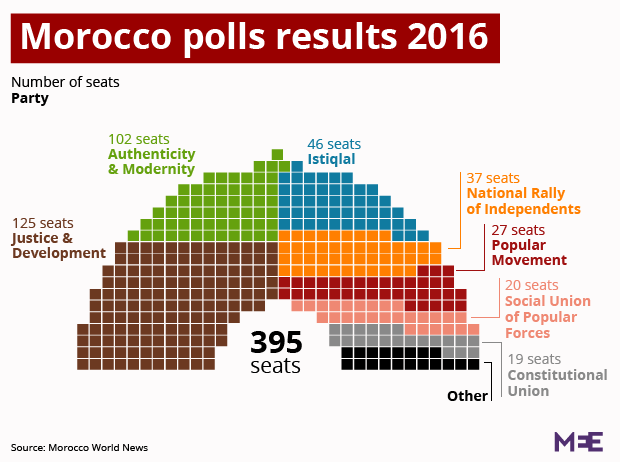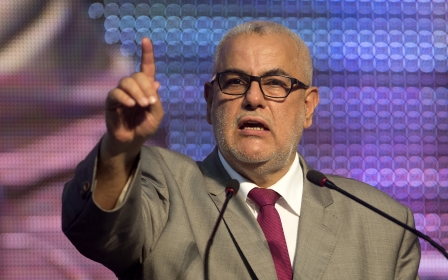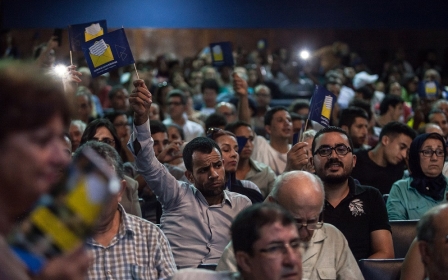How Morocco voted: Tallying results, looking ahead

On Friday, Moroccans hit the voting booths to elect the next government - the second legislative elections since 2011, when nationwide protests pushed the government to make constitutional reforms.
Results were announced just after midnight on Saturday, confirming a win for the ruling Islamist Party of Justice and Development (PJD).
The leading parliamentary opposition party, the Party of Authenticity and Modernity (PAM), trailed the PJD, coming in a close second. The elections wrapped up a two-week long campaign period that was marred by sex scandals and harsh political accusations between politicians.
The PJD won 125 seats out of the 395, extending its mandate for a second term, to PAM's 102 seats.
The legislative elections, held every five years, determine the makeup of the House of Representatives, the parliament's upper house. It is comprised of 395 seats, 305 of which are determined by the results of local lists in 92 electoral districts throughout the country, and 90 seats chosen based off parties' national lists comprised of solely women and youth, intended to meet a quota.
The PAM, a party led by Ilyas el-Omari, has faced criticism for their perceived closeness with the palace, after King Mohammed VI’s childhood friend and current royal adviser, Fouad Ali el-Himma, founded it in 2008.
Throughout the campaign, el-Omari dodged these claims, at one point even prompting the royal cabinet to release an unprecedented statement denouncing them - especially after they became talking points for members of the current ruling coalition, such as Nabil Benabdallah, secretary general of the Party of Progress and Socialism (PPS), which is a junior partner of the PJD.
While the PJD achieved a comfortable win, it was not without difficulties.
Throughout their five-year term since 2011, the PJD-led government, under the leadership of Prime Minister Abdelilah Benkirane, has had to contend with a growing opposition, mainly aimed at the government's austerity measures. Under Benkirane's mandate, the government accrued the highest amount of foreign debt since 1998, forcing the government to cut subsidies and public spending. This prompted widespread outrage, spanning from nationwide labour union strikes to violently repressed protests by young teachers.
One of the main surprises during the election was the rise of the Federation of the Democratic Left (FGD) - an alliance of three leftist parties, which included members of the February 20th Movement.
Their leader, Nabila Mounib, is the first woman to lead a major political movement in Morocco and was heavily covered by the media. Participating in legislative elections for the first time, the FGD scored a disappointing result in gaining just two seats in parliament, winning in upper- and middle-class districts in both Rabat and Casablanca. Mounib, who ran on the national list, failed to win a seat in parliament.
On election day, social media was rife with videos demonstrating alleged voting infractions, including ballot-box stuffing and election administrators carrying off ballot boxes into their cars.
Throughout the day, the Ministry of Interior released statements denying these allegations. However, on Sunday, two days after the elections, the country's top human rights body - established by royal decree - conceded in their preliminary report that a number of infractions had been reported and are currently being investigated. Their main point of grievance, however, was the low voter turnout.
At only 43 percent of the registered voters, it could be argued that it was the boycott campaign that truly won the elections. Movements like the Adl wal Ihsan (Justice and Charity) Movement and Annahj Addimocrati (the Democratic Way) boycotted the polls, motivated primarily by their opposition to the political and legal system, which places a majority of power and decision-making in the hands of the king and his cabinet.
For now, the PJD faces a tough road ahead in forming the government coalition. After elections in 2011, the PJD's government was disrupted when their coalition partners in the Istiqlal Party, led by Hamid Chabat, decided to leave the coalition and join the opposition. For weeks in 2013 the status of the government was up in the air - all while King Mohammed VI was in France. It was then that the Rally of National Independents, under the leadership of current foreign minister Salaheddine Mezouar, shifted from the opposition to the coalition government, taking the Istiqlal Party's place and prompting a major cabinet reshuffle.
The PAM and PJD have openly written off the possibility of joining forces with one another to form a coalition government, minimising the choices the PJD has to decide with whom to ally.
The possibility remains that the PJD could opt for forming a coalition government with its initial allies in 2011, which included the Istiqlal Party, the Popular Movement (MP), and the Party of Progress and Socialism (PPS).
For now, however, there is no clear path for the future coalition government, and negotiations could take months, leaving many Moroccans closely following the next stages on the edges of their seats.
New MEE newsletter: Jerusalem Dispatch
Sign up to get the latest insights and analysis on Israel-Palestine, alongside Turkey Unpacked and other MEE newsletters
Middle East Eye delivers independent and unrivalled coverage and analysis of the Middle East, North Africa and beyond. To learn more about republishing this content and the associated fees, please fill out this form. More about MEE can be found here.





